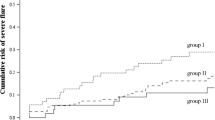Abstract
To assess serum 25-hydroxyvitamin D (25-OH vitamin D) status in Saudi children with systemic lupus erythematosus (SLE) and determined its association with clinical, laboratory variables and disease activity. This cross-sectional study comprised children with SLE who are followed at Pediatric Lupus Clinic. All patients reviewed for demographic data, age of first disease manifestations, and disease duration. All included patients evaluated for disease activity, which is completed by using the SLE Disease Activity Index (SLEDAI) and laboratory parameters included a vitamin D profile, bone markers at enrollment and 3 months later. All patients treated with Cholecalciferol (vitamin D3 2000 IU daily) and calcium supplement (Caltrate 600 mg twice daily). Twenty-eight patients (26 female) with mean age of 9.7 years completed the evaluation. Fifteen patients had more than one major organ involvement. Most of the patients are on daily vitamin D3 supplement (800 IU) prior enrollment. The baseline assessment revealed 24 patients had low levels of serum 25-OH vitamin D levels, with a mean of 51.1 ± 33.6 nmol/L; 25 patients had high autoantibodies; and 18 patients had high protein/creatinine ratio, with a mean of 0.9 ± 1.7. Bone density was subnormal with a mean of 0.9 ± 1. The mean disease activity was 6 ± 5.6. Levels of 25-OH vitamin D correlated inversely with autoantibodies and SLEDAI and positively with bone density but not statistically significant. After 3 months, treatment of vitamin D3 (2000 IU daily) and Caltrate (600 mg twice daily), 17 patients had improvement in SLEDAI score and autoimmune markers. Disease activity of childhood SLE is probably linked with low serum 25-OH vitamin D levels. Accordingly, high daily vitamin D3 supplement could potentially impact disease activity of childhood SLE. Further follow up and more patients needed to confirm this finding.
Similar content being viewed by others
References
Brunner H, Gladman D, Ibañez D, Urowitz M, Silverman E (2008) Difference in disease features between childhood-onset and adult-onset systemic lupus erythematosus. Arthritis Rheum 58:556–562
Papadimitraki E, Isenberg D (2009) Childhood- and adult-onset lupus: an update of similarities and differences. Expert Rev Clin Immunol 5:391–403
Vachvanichsanong P, Dissaneewate P, McNeil E (2011) Twenty-two years’ experience with childhood-onset SLE in a developing country: are outcomes similar to developed countries? Arch Dis Child 96:44–49
Huggins J, Burnner H (2006) Targeting B cells in the treatment of childhood-onset systemic lupus erythematosus. J Pediatr 148:571–573
Cutolo M (2009) Vitamin D and autoimmune rheumatic diseases. Rheumatology (Oxford) 48:210–212
Bonakdar Z, Jahanshahifar L, Jahanshahifar F, Gholamrezaei A (2011) Vitamin D deficiency and its association with disease activity in new cases of systemic lupus erythematosus. Lupus 20:1155–1160
Chaiamnuay S, Chailurkit L, Narongroeknawin P, Asayatanabodee P, Laohaiaroensombat S, Chaiamnuay P (2013) Current daily glucocorticoid use and serum creatinine levels are associated with lower 25 (OH) vitamin D levels in Thai patients with systemic lupus erythematosus. J Clin Rheumatol 19:121–125
Mok C (2013) Vitamin D and systemic lupus erythematosus: an update. Expert Rev Clin Immunol 9:453–463
Petri M, Bello K, Fang H, Magder L (2013) Vitamin D in systemic lupus erythematosus: modest association with disease activity and the urine protein-to-creatinine ratio. Arthritis Rheum 65:1865–1871
Bogaczewicz J, Sysa-Jedrzeiowska A, Arkusewska C, Zabek J, Kontny E, McCauliffe D et al (2012) Vitamin D status in systemic lupus erythematosus patients and its association with selected clinical and laboratory parameters. Lupus 21:477–484
Casella C, Seguro L, Takayama L, Medeiros D, Bonfa E, Pereira R (2012) Juvenile onset systemic lupus erythematosus: a possible role for vitamin D in disease status and bone health. Lupus 21:1335–1342
Robinson A, Thierry-Palmer M, Gibson K, Rabinovich E (2012) Disease activity, proteinuria, and vitamin D status in children with systemic lupus erythematosus and juvenile dermatomyositis. J Pediatr 160:297–302
Petri M, Orbai A, Alarcón G, Gordon C, Merrill J, Fortin P et al (2012) Derivation and validation of the Systemic Lupus International Collaborating Clinic classification criteria for systemic lupus erythematosus. Arthritis Rheum 64:2677–2686
Brunner H, Silverman E, To T, Bombardier C, Feldman B (2002) Risk factors for damage in childhood-onset systemic lupus erythematosus: cumulative disease activity and medication use predict disease damage. Arthritis Rheum 46:436–444
Mok C, Wong S, Ma K (2012) Childhood-onset disease carries a higher risk of low bone mineral density in adult population of systemic lupus erythematosus. Rheumatology (Oxford) 51:468–475
Sen D, Keen R (2001) Osteoporosis in systemic lupus erythematosus: prevention and treatment. Lupus 10:227–232
Sumethkul K, Boonyaratavej S, Kitumnuaypong T, Angtharauk S, Cheewasat P, Manadee N et al (2013) The predictive factors of low serum 25-hydroxyvitamin D and vitamin D deficiency in patients with systemic lupus erythematosus. Rheumatol Int 33:1461–1467
Abou-Raya A, Abou-Raya S, Helmii M (2013) The effect of vitamin D supplementation on inflammatory and hemostatic markers and disease activity in patients with systemic lupus erythematosus: a randomized placebo-controlled trail. J Rheumatol 40:265–272
vinh quốc Luong K, Nguyễn L (2012) The beneficial role of vitamin D in systemic lupus erythematosus (SLE). Clin Rheumatol 31:1423–1435
Szodoray P, Tarr T, Bazso A, Poor G, Szegedi G, Kiss E (2011) The immunopathological role of vitamin D in patients with SLE: data from a single centre registry in Hungary. Scand J Rheumatol 40:122–126
Conflict of interest
None
Author information
Authors and Affiliations
Corresponding author
Rights and permissions
About this article
Cite this article
AlSaleem, A., AlE’ed, A., AlSaghier, A. et al. Vitamin D status in children with systemic lupus erythematosus and its association with clinical and laboratory parameters. Clin Rheumatol 34, 81–84 (2015). https://doi.org/10.1007/s10067-014-2811-z
Received:
Revised:
Accepted:
Published:
Issue Date:
DOI: https://doi.org/10.1007/s10067-014-2811-z




